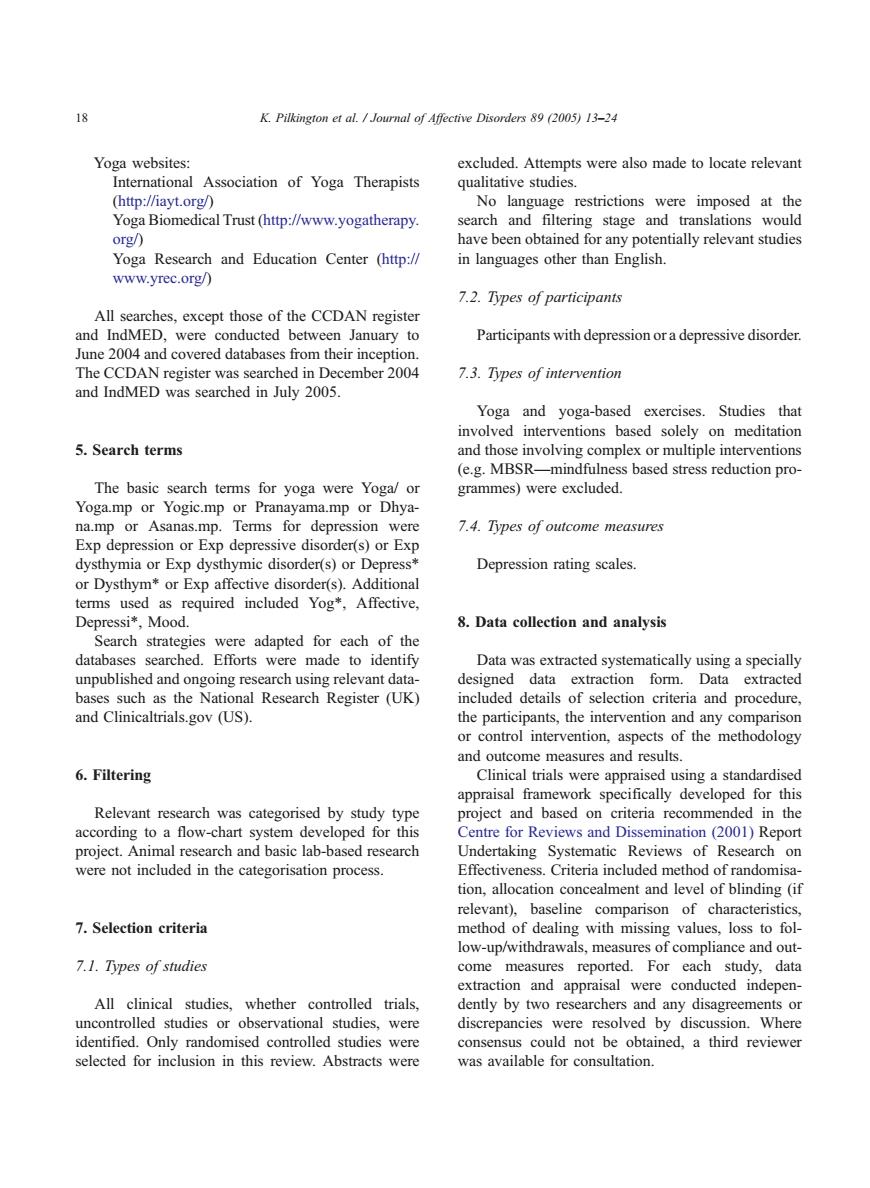正在加载图片...

18 K.Pilkington et al.Journal of Affective Disorders 89 (2005)13-24 Yoga websites: excluded.Attempts were also made to locate relevant International Association of Yoga Therapists qualitative studies. (http://iayt.org/) No language restrictions were imposed at the Yoga Biomedical Trust(http://www.yogatherapy. search and filtering stage and translations would org) have been obtained for any potentially relevant studies Yoga Research and Education Center (http:// in languages other than English. www.yrec.org/) 7.2.Types of participants All searches,except those of the CCDAN register and IndMED,were conducted between January to Participants with depression or a depressive disorder. June 2004 and covered databases from their inception. The CCDAN register was searched in December 2004 7.3.Types of intervention and IndMED was searched in July 2005. Yoga and yoga-based exercises.Studies that involved interventions based solely on meditation 5.Search terms and those involving complex or multiple interventions (e.g.MBSR-mindfulness based stress reduction pro- The basic search terms for yoga were Yoga/or grammes)were excluded. Yoga.mp or Yogic.mp or Pranayama.mp or Dhya- na.mp or Asanas.mp.Terms for depression were 7.4.Types of outcome measures Exp depression or Exp depressive disorder(s)or Exp dysthymia or Exp dysthymic disorder(s)or Depress* Depression rating scales. or Dysthym*or Exp affective disorder(s).Additional terms used as required included Yog*,Affective, Depressi*,Mood. 8.Data collection and analysis Search strategies were adapted for each of the databases searched.Efforts were made to identify Data was extracted systematically using a specially unpublished and ongoing research using relevant data- designed data extraction form.Data extracted bases such as the National Research Register (UK) included details of selection criteria and procedure. and Clinicaltrials.gov (US). the participants,the intervention and any comparison or control intervention,aspects of the methodology and outcome measures and results. 6.Filtering Clinical trials were appraised using a standardised appraisal framework specifically developed for this Relevant research was categorised by study type project and based on criteria recommended in the according to a flow-chart system developed for this Centre for Reviews and Dissemination(2001)Report project.Animal research and basic lab-based research Undertaking Systematic Reviews of Research on were not included in the categorisation process. Effectiveness.Criteria included method of randomisa- tion,allocation concealment and level of blinding (if relevant),baseline comparison of characteristics, 7.Selection criteria method of dealing with missing values,loss to fol- low-up/withdrawals,measures of compliance and out- 7.1.Types of studies come measures reported.For each study,data extraction and appraisal were conducted indepen- All clinical studies,whether controlled trials, dently by two researchers and any disagreements or uncontrolled studies or observational studies,were discrepancies were resolved by discussion.Where identified.Only randomised controlled studies were consensus could not be obtained,a third reviewer selected for inclusion in this review.Abstracts were was available for consultation.Yoga websites: International Association of Yoga Therapists (http://iayt.org/) Yoga Biomedical Trust (http://www.yogatherapy. org/) Yoga Research and Education Center (http:// www.yrec.org/) All searches, except those of the CCDAN register and IndMED, were conducted between January to June 2004 and covered databases from their inception. The CCDAN register was searched in December 2004 and IndMED was searched in July 2005. 5. Search terms The basic search terms for yoga were Yoga/ or Yoga.mp or Yogic.mp or Pranayama.mp or Dhyana.mp or Asanas.mp. Terms for depression were Exp depression or Exp depressive disorder(s) or Exp dysthymia or Exp dysthymic disorder(s) or Depress* or Dysthym* or Exp affective disorder(s). Additional terms used as required included Yog*, Affective, Depressi*, Mood. Search strategies were adapted for each of the databases searched. Efforts were made to identify unpublished and ongoing research using relevant databases such as the National Research Register (UK) and Clinicaltrials.gov (US). 6. Filtering Relevant research was categorised by study type according to a flow-chart system developed for this project. Animal research and basic lab-based research were not included in the categorisation process. 7. Selection criteria 7.1. Types of studies All clinical studies, whether controlled trials, uncontrolled studies or observational studies, were identified. Only randomised controlled studies were selected for inclusion in this review. Abstracts were excluded. Attempts were also made to locate relevant qualitative studies. No language restrictions were imposed at the search and filtering stage and translations would have been obtained for any potentially relevant studies in languages other than English. 7.2. Types of participants Participants with depression or a depressive disorder. 7.3. Types of intervention Yoga and yoga-based exercises. Studies that involved interventions based solely on meditation and those involving complex or multiple interventions (e.g. MBSR—mindfulness based stress reduction programmes) were excluded. 7.4. Types of outcome measures Depression rating scales. 8. Data collection and analysis Data was extracted systematically using a specially designed data extraction form. Data extracted included details of selection criteria and procedure, the participants, the intervention and any comparison or control intervention, aspects of the methodology and outcome measures and results. Clinical trials were appraised using a standardised appraisal framework specifically developed for this project and based on criteria recommended in the Centre for Reviews and Dissemination (2001) Report Undertaking Systematic Reviews of Research on Effectiveness. Criteria included method of randomisation, allocation concealment and level of blinding (if relevant), baseline comparison of characteristics, method of dealing with missing values, loss to follow-up/withdrawals, measures of compliance and outcome measures reported. For each study, data extraction and appraisal were conducted independently by two researchers and any disagreements or discrepancies were resolved by discussion. Where consensus could not be obtained, a third reviewer was available for consultation. 18 K. Pilkington et al. / Journal of Affective Disorders 89 (2005) 13–24